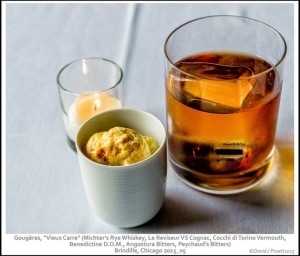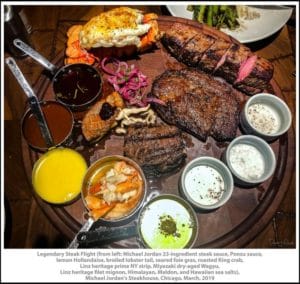Chef Andrew Zimmerman’s Sepia, like the late, lamented Henri, occupies a special place in the fine dining world in Chicago. The food is world class. The restaurant has held one Michelin star since Michelin started rating Chicago restaurants in 2011.

The space, a building in the Warehouse District built as a print shop over a century ago, has been beautifully renovated and decorated in a way that somehow connects to the building’s history, but still feels modern. The main dining area is filled with warm wood, bronze and gold tones that are elegant, but comfortable. The staff is knowledgeable and friendly – just familiar enough to make you feel at home, not so familiar that they act like you are an old college chum.
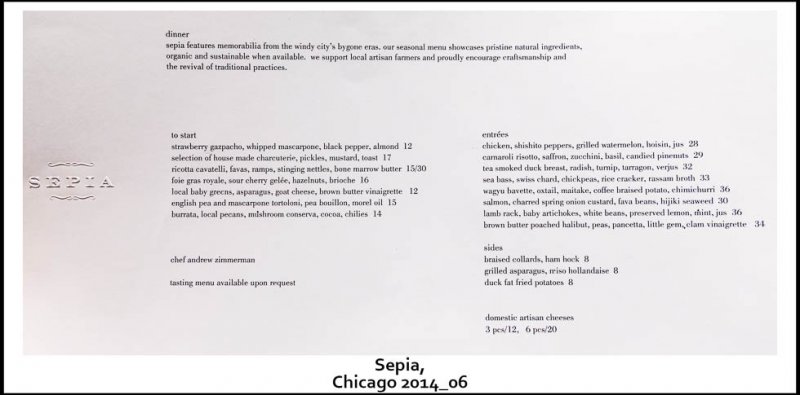
Chef Zimmerman’s menus are driven by seasonal and local ingredients, which is almost the only politically correct way a chef can describe his work these days. In this case, however, it is not just a mantra to be repeated for the masses. The menu features plenty of seasonal fruits and vegetables from local farms, as well as local meats, craft beers and cheeses. But this is Chicago, not southern California, so ingredients from elsewhere in the world do round out a varied menu.
Sepia offers a chef’s tasting menu, but it is just a footnote on the menu and, strangely for me, I have never ordered it. I hereby pledge to fix that on my next visit, as putting yourself (or at least your dinner selections) in Chef Zimmerman’s hands for an evening strikes me as a very good idea.
On this night, however, Valeria and I were just in the mood for a drink, a couple of courses, and a glass of wine in a quiet, comfortable space. Sepia was just the ticket.
I am primarily a wine guy, but I do enjoy a good cocktail. A classic Gin Martini or a great Manhattan-style cocktail made with an excellent Bourbon, Rye, Canadian or Irish Whiskey (depending on my mood and how heavy I want the cocktail to be) are my go-to drinks. Unfortunately, we have suffered through a depressing period in the US where garishly colored and sickly sweet “Martinis” gave the term a bad name, much as the White Zinfandel craze once destroyed the reputation of rosé wines. Happily, that has changed in recent years. There are well-trained and dedicated mixologists in bars and restaurants all over the country now. They approach their craft with the same knowledge and enthusiasm for quality ingredients assembled in balanced, delicious ways that chefs do with their menus.
Griffin Elliott is currently the Head Bartender at Sepia. He has been honing his craft for years with self study and working with master mixologists at Michelin-starred restaurants and top-flight bars. I decided to try something quite different for me, the White Martinez.
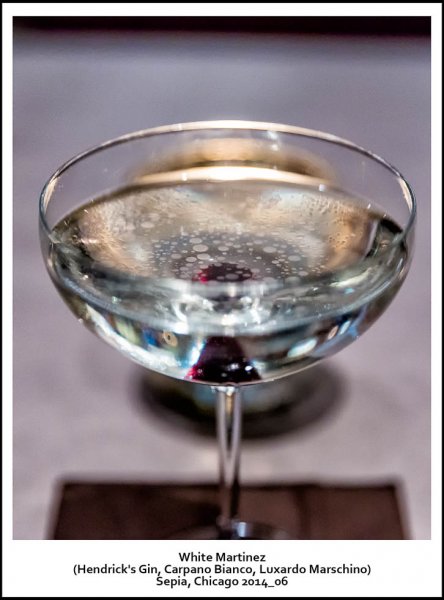
A blend of Hendrick’s Gin, Carpano Bianco and a Luxardo Maraschino cherry, it was light and refreshing – a great apéritif.
Hendrick’s is a Scottish Gin, which may sound like an oxymoron but it’s true. Henrick’s was introduced in 1999 by Scottish distillers WIlliam Grant and Sons, who apparently had not heard that the world was going to end on December 31 of that year. It has a unique flavor profile because in addition to the juniper berries and some of the other botanicals that give gins their characteristic flavors and aromas, Hendrick’s is flavored with rose essence and cucumber essence, which gives it a unique aroma and flavor profile. Don’t worry, there is no peat smokiness in this beverage so it doesn’t taste a thing like Scotch Whisky. It is sold in a distinctive dark blue apothecary’s jar and they have a very cool website here.
A very flavorful, multigrain bread appeared on the table just before the drinks did. It had a nice crust and a nice chew – sort of a mini-baguette.
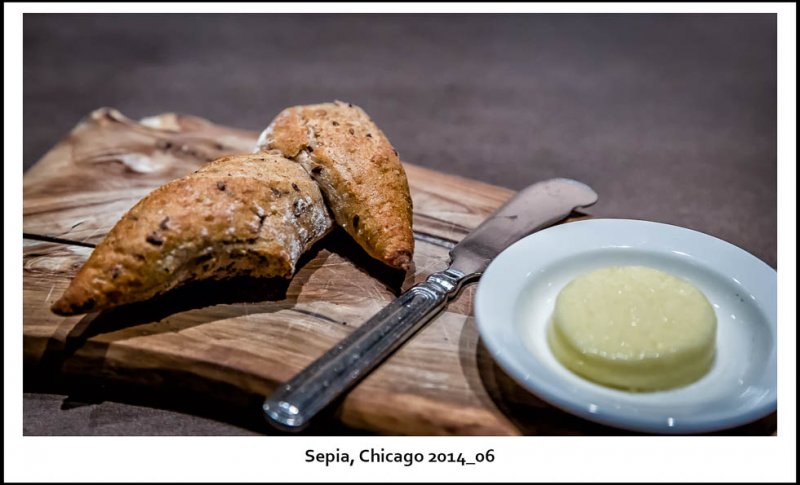
The butter was at a spreadable temperature and, while I didn’t ask, I suspect it came from a nearby Wisconsin farm.
A few minutes later our waiter brought another nibble for us to enjoy with our drinks. The amuse bouche that evening was Carrot Custard with Basil and Granola.

Sounds like health food, but it was a very tasty bite. The flavor of the smooth custard was complimented by the flavor and texture of a basil leaf and basil gel and the crunchy granola added the final taste and texture notes.
Valeria’s first course was a light and refreshing Strawberry Gazpacho with whipped Marscapone, black pepper and almonds. Gazpacho is a wonderful cold summer soup that originated in Spain. There are hundreds of traditional and modern variations of this soup, but traditional recipes start with a tomato base, to which cucumber, bell peppers, onions and garlic, olive oil and wine vinegar are added. The vegetables are all peeled and used raw. A good portion of them are blend to a smooth purée, to which additional small pieces of the vegetables can be added and left relatively course, blended partially, or the whole thing can be blended to a smooth purée with just a few pieces of vegetable as garish. Stale bread is often included to thicken the mixture and, of course, it is seasoned with salt and pepper to taste.
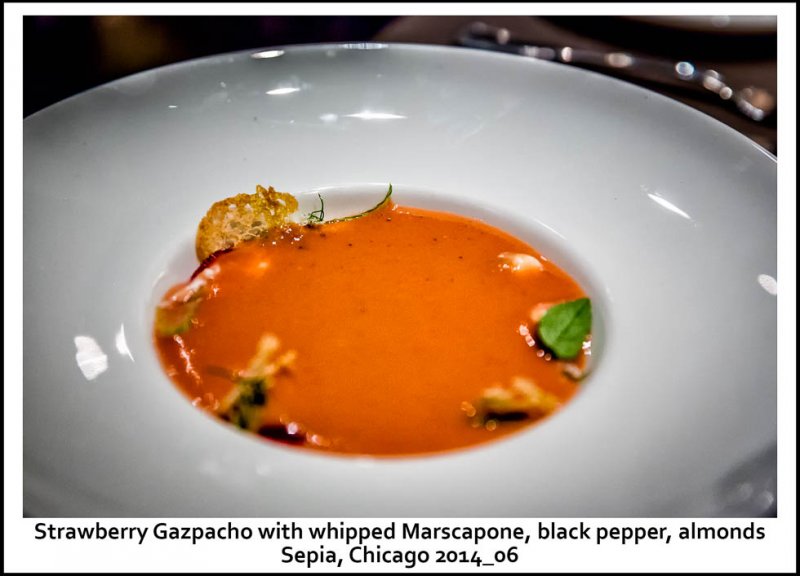
You can read more about the origins and variations on Gazpacho here. The variation that we enjoyed at Sepia included fresh strawberries (which were very much in season) in what tasted like a fairly traditional base. Whatever the details of the recipe, it was delicious.
My choice for a first course was a bit less heart healthy: Foie Gras Royale with sour cherry gelée, hazelnuts and brioche. I could go through a long description of the preparation, but here is a YouTube video of Chef Zimmerman himself preparing the dish.
Update, November 2016: I just discovered that the video I had included in this article is no longer available on YouTube. Here, instead, is a photograph of the finished product. A layer of foie gras mousse is sealed with a sour cherry gelée (jelly), topped with some hazelnuts and served with slices of buttery-rich brioche (egg and butter bread) toast.

Valeria chose Tea Smoked Duck Breast with radish, turnips, tarragon and verjus for her entrée. It was perfectly pan-fried to medium rare with a nice, crispy skin. The pan was deglazed with verjus to make a very light sauce. Verjus is the juice of unripe grapes, which is quite acidic and typically used in place of vinegar in sauces and salad dressings. It is not quite as sharp as vinegar. The juice is not fermented, so it is non-alcoholic.
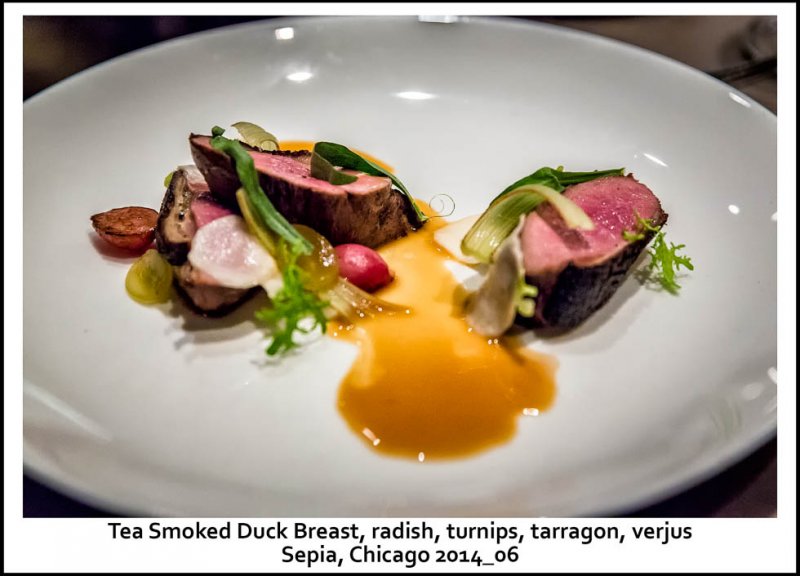
My entrée was a Wagyu Bavette with oxtail, maitake mushroom, coffee braised potato and hijiki seaweed. Wagyu literally means “Japanese cow” and refers to several breeds of cow raised in Japan that naturally develop a lot of the marbling (i.e., fat) that is what makes prime beef prime. The most famous Wagyu is farmed in the Japanese prefecture of Kobe, where the cattle may have beer or sake included in their diet. They may also be massaged with more beer or sake. At any rate, the highest quality Wagyu beef from Japan, Australia or the US is incredibly tender, juicy, fatty and, of course, expensive.
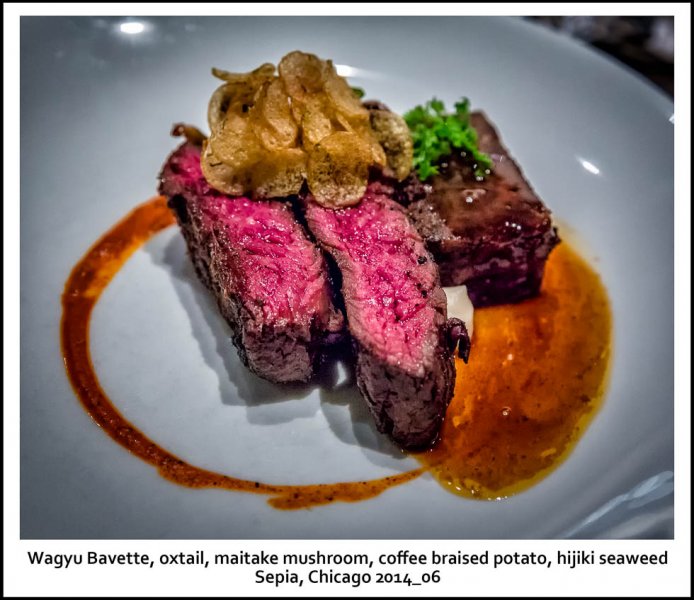
I confess I had never heard of a “Bavette” of beef before I saw it on the menu. Our waiter said it was a muscle taken from the shoulder. Perhaps I should have left it at that, but I had to look it up. Big mistake, as the term is apparently well-defined in France, not so much in the US. What the French call a bavette de flanchet is called a Flank Steak in the US – a great piece of meat to grill. The French bavette de aloyau is a Skirt Steak here – traditionally the cut used in steak fajitas. But these are both from the belly of the cow, not the shoulder.
If you have ever trimmed a whole beef tenderloin, you know there is a long, thin strip of meat that is usually removed and used for some other purpose. That is known simply as a bavette in France. None of these looked like the cut of beef I was served, nor did it look like any shoulder cut I have ever seen, so I am still not sure just where on the cow this steak came from. Nevertheless, it was tender, juicy and had a wonderful beefy flavor. It was served with a block of oxtail that had been slow-cooked and formed into a boneless brick, along with some Maitake mushrooms and potatoes that had been braised in coffee, then fried crisp. The dish was deeply, richly flavored – an umami bomb.
Our side dishes may not seem to important after that, but they were also delicious. For our green veggie, Grilled Asparagus with a miso Hollandaise. Grilled just enough

to pick up some charred flavor, but still a nice tender-crisp texture.
Our last dish: Duck Fat Fried Potatoes.

This has been a stable at Sepia for years. Fried potatoes conjure up visions of dinners in a cheap diner with the spuds swimming is a sea of grease. That was not the case with these golden-brown beauties. Properly fried food does not take up large quantities of fat, and these were perfect.
I have been to Sepia several times for lunch and dinner and the food, ambience and service have been consistently excellent. Add this to the long list of must-try restaurants for foodies in Chicago, although you do not have to be a foodie to appreciate this destination.
Sepia
Address: 123 North Jefferson St, Chicago, IL 60661
Phone: (312) 441-1920
Reservations: opentable.com
Website: sepiachicago.com
Dress Code: Casual Elegant
Price Range: $50 and over
Lunch: Monday: Friday: 11:30am—2:00pm
Dinner: Sunday: 5:00pm—9:00pm
Monday—Thursday: 5:15pm—9:30pm
Friday & Saturday: 5:15pm – 10:30pm
Lounge: Opens daily at 4:30pm
Payment: AMEX, Diners Club, Discover, MasterCard, Visa
Chicago, IL 60661
